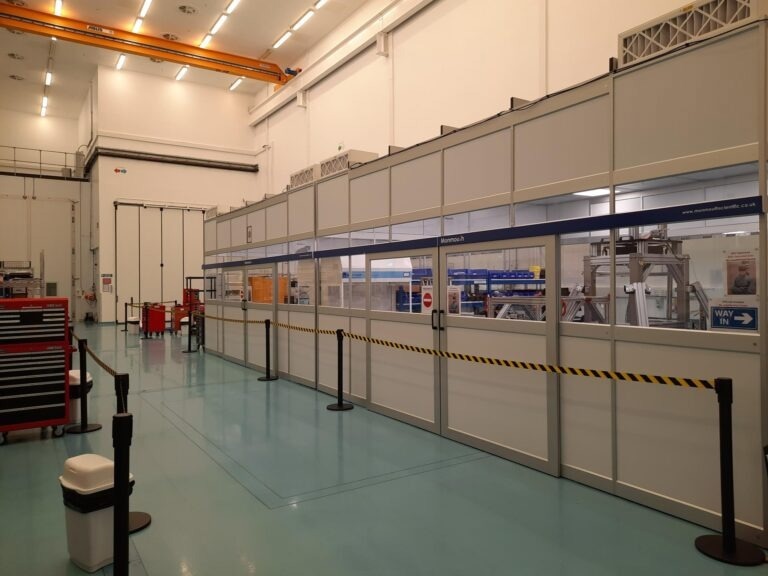Surrey Satellite Technology (SSTL) has been a pioneer in space innovation for over four decades. The company, headquartered in Guildford, delivers customizable mission solutions for Earth observation, scientific research, communications, and navigation.
Key objectives
Facing a surge in project workload, Andrew Norton approached Monmouth Scientific seeking a solution to ensure a highly clean environment for SSTL's Engineering teams. This environment would be utilized for assembling and testing complex Optical Payloads for satellites.
These sophisticated and bespoke technologies facilitate communication between space and Earth, enabling tasks like Earth and lunar observation, planetary investigation, weather data gathering, deep-space exploration, and navigation.

Image Credit: Monmouth Scientific Limited
Monmouth Scientific's solution
- 6 m x 5 m ISO Class 7 Aluminium Modular Cleanrooms
- Circulaire® HLFT1200 Horizontal Laminar Flow Cabinets
After careful evaluation, Monmouth Scientific's experienced team identified the Aluminium Modular Cleanroom as the perfect fit for meeting the needs of Surrey Satellite Technology. This solution is well-suited for assembling delicate technologies that must endure the harsh conditions of space.
At SSTL's headquarters, two Cleanrooms were installed, comprising a 6 m x 5 m Satellite Engineering Zone, LED Lighting Panels throughout, and 4 m wide Flexible Curtain Entry/Exit Points. These entry/exit points enable efficient movement of large equipment in and out of the Manufacturing Cell.
The Cleanrooms house four CAMT2000 Clean Air Modules, ensuring positive pressure and maintaining an ISO 14664-1 clean environment.
The CAM unit filters air through HEPA filters (with 99.997% efficiency at 0.3 microns) before creating positive pressure within the environment, providing up to 1800 m3 of HEPA-filtered air, equating to 60 clean air changes per hour.
Based on initial validation reports and particle counts, the two Cleanrooms achieve an ISO Class 5 environment, containing fewer than 100 particles (0.5 microns or larger in diameter) per cubic foot of air.
For particularly complex processes, SSTL required controlled zones within the Cleanroom, meeting an even cleaner ISO Class 4 level.
To fulfill this requirement, CirculaireÒ HLFT1200 Horizontal Laminar Flow Cabinets were installed in the Cell, guaranteeing a particle-free working environment and surpassing cleanliness requirements while providing exceptional protection.
The Cleanroom structures are constructed using a smooth profile aluminum framework, aluminum composite, and clear non-break polycarbonate windowpanes. The solution's modularity allows for easy reconfiguration and extension to cater to SSTL's future requirements and project demands.
These genuinely look like a quality lab and by using them as manufacturing cells we have been able to apply good practices from the manufacturing world.
We’ve been able to impart flexibility and agility into the system that allows these manufacturing cells to be used across payloads that are highly bespoke and rarely the same.
The team at Monmouth Scientific were engaging throughout the entire process and provided a cost-effective solution to our requirements."
Andrew Norton, Project Lead, Surrey Satellite Technology
About Monmouth Scientific Limited
At Monmouth Scientific environmentally responsible recirculating technology is the core of our expertise.
Our specialised Fume Cupboard, Laminar Flow, Biological Safety, Powder Containment, and ISO Class Cleanroom solutions provide the best protection and performance for your personnel.
A UK Market Leader in Clean Air Solutions and at the forefront of the industry, we employ cutting-edge technologies and innovative engineering, to ensure that our solutions consume minimal energy while delivering optimal performance.
As experts in clean environments and laboratory personnel safety, our team continue to proudly pioneer innovative new technologies to guarantee the highest levels of safety for a diverse client base including;
- Laboratory
- Research
- Pharmaceutical
- Electronics
- Aerospace
Sponsored Content Policy: News-Medical.net publishes articles and related content that may be derived from sources where we have existing commercial relationships, provided such content adds value to the core editorial ethos of News-Medical.Net which is to educate and inform site visitors interested in medical research, science, medical devices and treatments.